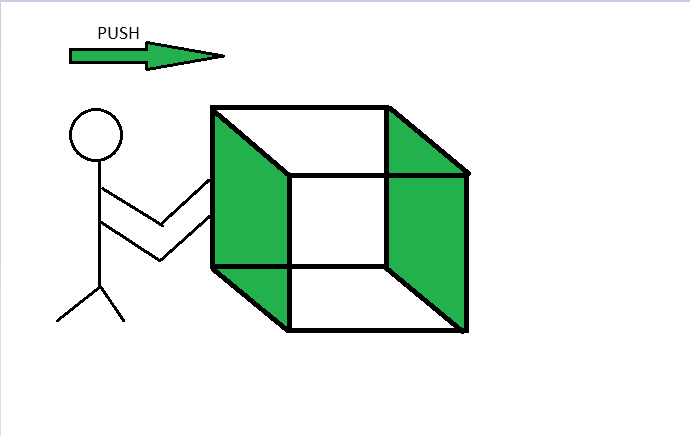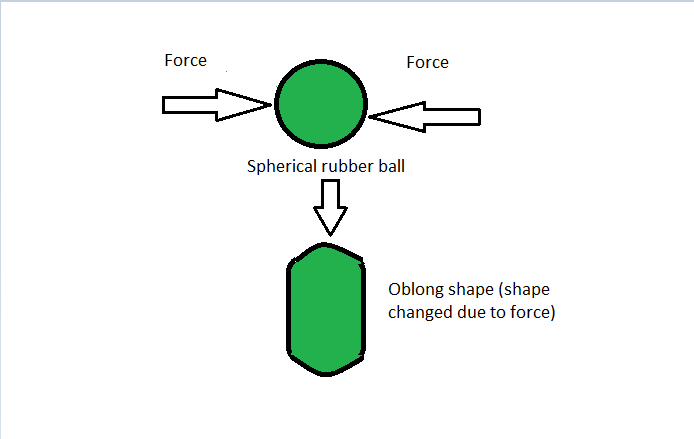在我们的日常生活中,可以观察到需要付出一些努力才能使处于静止状态的物体运动或停止移动的物体。它正在经历这种艰苦的努力,并说我们必须推拉物体以改变其运动状态。力的概念仅基于此推,击或拉动。
因此,“力”可以定义为对任何会改变其运动状态的对象的推动,拉动或撞击。力被另一个物体施加在一个物体上。
例如,:当盒子被推动时,它向前移动并改变其运动状态,因此可以说,当以推力的形式向盒子施加力时,它的状态从静止变为运动。类似地,假设盒子被绳索绑住并被人拉动,那么盒子将改变其静止状态并开始向拉动方向移动。这是力的另一个例子。

以推力的形式向盒子施加力
力还可以改变任何物体的形状和大小。施加的力越大,观察到的任何物体的形状和大小的变化就越大。
例如: ,当力施加到球形橡胶球上时,它的形状从球形变为长方形。
另一个例子可以是橡胶弹簧,因为当以拉力的形式向弹簧施加力时,它会膨胀并因此改变其形状。

由于施加了力,球的形状发生了变化
以此方式,该力在我们的日常生活中具有许多应用,例如由于骑自行车时脚踩踏板而产生的力,球拍对球拍施加的力。存在法向力的一般情况是当一个人站在地面上时,即地面在该人身上施加的力的大小等于该人的体重。
力的作用
从以上示例中,可以总结出各种力的作用,如下所示:
- 它可以改变身体的运动状态。
- 它可以改变运动物体的方向。
- 它可以改变身体的大小或形状。
- 它可以加快运动物体的速度。
- 它会减慢运动物体的速度。
部队类型
有两种类型的力,取决于是否看到或感觉到力的作用。这些如下:
1)力量均衡
2)力量不平衡
力量均衡
作用在物体上的不变而相反的力不会改变该物体的静止或运动状态,称为平衡力。
当物体不移动或物体以相同的速度和相同的方向连续移动时,作用在物体上的力被认为是平衡的(或者如果没有力作用在物体上)。因此,作用在物体上的所有力的合力为零的力的类型称为平衡力。
例如: ,将木块放在桌子上,并在木块的两侧施加相等的力时,木块将不会向任何方向移动。

作用在块体上的平衡力
显然,在块的左侧和块的右侧施加120 N的力时,力是平衡的。作用在盒子上的净力必须等于两个力F 1和F 2之差:
F = F 1 – F 2 = 120 N – 120 N = 0N。
由于合力/净力因此为零,因此滑块不会更改其静止状态。
另一个示例可以是放置在粗糙表面上的盒子,因此,如果用较小的力推动盒子,则盒子不会改变其位置,也不会由于沿与推动盒子相反的方向上的摩擦力而保持静止。这意味着盒子会平衡作用在盒子上的推力和盒子与表面之间的摩擦力,并且摩擦力相等,因此盒子不会移动。
力量不平衡
作用在物体上的不平等且相反的力会朝较大的施加力方向移动物体,这称为不平衡力。
当作用在物体上的净力不为零时,作用在物体上的力被称为不平衡力。当作用在物体上的净力产生不平衡力时,由于该力使物体加速。这意味着作用在物体上的净力可以改变其速度的方向或大小。
例如:考虑平衡力中描述的盒子的相同情况,区别在于所施加的两个力在块体的相对侧上的大小不同,因此,块体在较大力的方向上移动。

作用在块体上的平衡力
显然,当在块的左侧施加120 N的力而在块的右侧施加60 N的力时,这些力是不平衡的。
作用在盒子上的净力必须等于两个力F 1和F 2之差:
F = F 1 – F 2 = 120 N – 60 N = 60N。
由于F 1是较大的力,因此,滑块将沿F 1的方向移动。
因此,可以得出结论,当作用在该物体上的所有力均已平衡且没有净外力作用在该物体上时,该物体将以恒定的速度运动。
当对物体施加不平衡的力时,物体的速度或运动方向都会发生变化。
因此,为了加速物体的运动,需要不平衡的力。只要施加了这种不平衡力,其速度(或运动方向)的变化就会继续。
部队单位
由于力既有大小又有方向,因此它是一个Vector量。
力的方向可以简单地借助箭头来表示,而要表示力的大小,则需要一些测量单位。因此,力的标准单位如下:
- 力可以在国际标准单位制(SI单位)中以牛顿(N)表示。
- 而以达因为单位,以厘米克为单位的秒制(CGS单位)。
注意:在国际单位制中,牛顿等于Kg m / s 2
力的表示
力用符号(F)表示。力的大小可以用质量(m)和加速度(a)的矢量积表示。因此,力的数学表示可写为:
F = m × a
其中,F是力,m是物体的质量,a是获得的加速度。
现在,由于加速度是运动物体速度的变化,因此,力的其他数学表示可以写成如下:
F = m × a
Since,
a = (v-u)/t
So,
F = m × (v-u)/t
其中,u和v分别是初始速度和最终速度,t是花费的时间。
解决的问题
问题1:假设一个箱子有2公斤重。应该对盒子施加多少力才能使其以8 m / s 2的加速度行进?
解决方案:
Given that,
The mass of the box, m = 2 kg and
The acceleration of the box a = 8m/s2.
The formula to calculate the force is:
F = m × a
So on putting the value of ‘m’ and ‘a’ in the above equation as:
F = 2 kg × 8 m/s2
= 16 kg m/s2 or 16 N.
问题2:质量为2 kg的球以5 m / s的初始速度运动,然后突然在0.02秒内静止。计算改变运动球状态的力。
解决方案:
Given that,
The initial velocity of the ball, u = 5 m/s,
The final velocity of the ball, v = 0 m/s,
The time taken, t = 0.02 s.
The formula to calculate the force is:
F = m × a
where, m is the mass and a is the acceleration.
and the formula to calculate the acceleration is:
a = (v-u)/t
where, t is the time taken, v and u are the initial and final velocities of the ball.
Substitute (v-u)/t for a in the first expression of force as:
F = m × (v-u)/t
Now, putting the given values in the above expression to calculate the force.
a = (0-5)/0.02 = -250 m/s2 [-ive sign simply represents the negative acceleration known as retardation ]
on putting this value in eq 1, we get
F = 2 kg × (0 m/s – 5 m/s)/0.02 s = 2 kg × -250 m/s2 = 500 N.
问题3:如果将一个木块放在木桌上,使得在木块的一侧施加100 N的力,而在另一侧施加40 N的力。方块会移动吗?如果是,则指定力的大小和力的方向。
解决方案:
Given that,
The force applied from one side of the block, F1 = 100 N and
The force applied from the other side of the block, F2 = 40 N.
The resultant force can be calculated as the difference between the two forces, which is:
100 N – 40 N = 60 N.
Since the resultant force is not zero, hence the block will surely move in the direction of F1 as F1 is a larger force in comparison to F2.
问题4:一个13公斤重的块以恒定的速度沿着地板滑动。块上的净力是多少?
解决方案:
Given that,
The mass of the block, m = 13 kg.
Since the block is sliding with a constant velocity, so net acceleration will be zero i.e. a = 0 m/s2.
The formula to calculate the force is:
F = m × a
Put all the given values in the above expression to calculate the force.
F = 13 × 0 m/s2 = 0 N.
问题5:平衡力和不平衡力有什么区别?
解决方案:
The differences between the balanced and the unbalanced forces are as follows:
|
Balanced Forces |
Unbalanced Forces |
|
| 1. | The resultant force is zero. | The resultant force is not zero. |
| 2. | It does not change the state of the rest of a body. | It can change the state of the rest of a body. |
| 3. | It cannot produce any acceleration. | It can produce an acceleration. |
| 4. | It cannot change the direction of the body. | It can change the direction of the body. |
| 5. | Forces are equal in magnitude. | Forces are unequal in magnitude. |
问题6.两个质量分别为10公斤和20公斤的球。它们各自的加速度分别为20 m / s 2和40 m / s 2 。求出各自力的比例。
解决方案:
The mass of the first ball, m1 = 10 kg.
The mass of the second ball, m2 = 20 kg.
The acceleration of the first ball, a1 = 20 m/s2.
The acceleration of the second ball, a2 = 40 m/s2.
Using the formulae:
F1 = m1 × a1 and
F2 = m2 × a2
Therefore,
F1 = 10 kg x 20 m/s2 = 200 N
Similarly,
F2 = 20 kg x 40 m/s2 = 800 N
Hence,
F1 : F2 = 200 N : 800 N = 1 : 4.